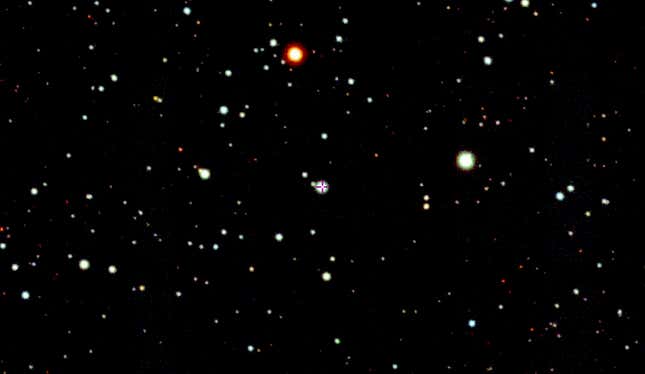
The peculiar elemental makeup of one star in the Milky Way could be due to a massive type of stellar collapse in the early universe, a team of astronomers announced today. The finding could help astronomers understand the diversity of ways in which the universe’s heavy elements, like gold, originated.
The star in question, SMSS J200322.54-114203.3, is 7,500 light-years from the Sun and sits in the halo on the periphery of our galaxy. The team believes a stellar explosion even more energetic than a supernova—called a “hypernova”—is responsible for the star’s unusual chemistry. Elements heavier than iron require intense forces to be created: The merging of neutron stars, as well as the collapse of large stars in supernova explosions, are two common ways. Heavy elements are forged when lighter elements absorb many neutrons, some of which decay into protons, eventually landing on a stable isotope of a heavy element. Those elements are then dispersed into the interstellar medium by the force of the explosion or collision, eventually ending up in other stars and on planets like Earth.
Scientists say this particular star’s chemistry—a very low iron content and very high amounts of nitrogen, zinc, europium, and thorium—pointed to a different source of heavy elements than the typical neutron star merger. Their research is published today in Nature.
“The key question this research addresses is, ‘How were the heaviest elements produced in the early universe?’” said David Yong, an astronomer at the Australian National University and lead author of the recent paper, in an email. “The mergers of neutron stars (the extremely dense remnants of massive stars) were recently confirmed as sources … Our results reveal magnetorotational hypernova (an energetic explosion of a rapidly rotating star with magnetic fields) as another source of those heavy elements.”
The team was looking for a star with a large amount of heavy elements like zinc, thorium, and europium. They sifted through 26,000 stars from the SkyMapper Southern Sky Survey, a project that has built up a catalogue of some 600 million objects in the night sky. They narrowed down to a set of 150 candidates, but only SMSS J200322.54-114203.3 had the specific high-nitrogen, high-zinc signature the team was searching for. The star simply had more heavy elements than it should, based on known rates and energies of star deaths.

“The extra amounts of these elements had to come from somewhere,” said Chiaki Kobayashi, an astronomer from the University of Hertfordshire in the United Kingdom, in an ARC Center press release. The team determined that the star formed some 13 billion years ago, quite early in the universe’s timeline, out of the soupy aftermath of a gargantuan hypernova. Hypernovae are really a type of supernova; they describe stellar explosions about 10 times more energetic than an ordinary supernova.
“Since the star has such low iron content, it must have formed when the Milky Way galaxy was very young,” Yong said. “Given the short time constraint, it is easier to produce all elements in a single event (magnetorotational hypernova) rather than in the neutron star merger scenario.”
The team believes this huge, magnetized, fast-spinning star collapsed 13 billion years ago, blasting elements hither and thither. Kobayashi’s models of the Milky Way’s chemical evolution suggest that hypernovae may have had a bigger part to play in shaping the galactic chemistry we see today.
Finding more stars with a similar makeup will likely help the team understand just how important hypernovae were in the early cosmic kitchen. For now, SMSS J200322.54-114203.3 is the sole indicator of the elemental mystery at large.
More: Astronomers Think They’ve Spotted a Rare Kind of Supernova Only Predicted to Exist